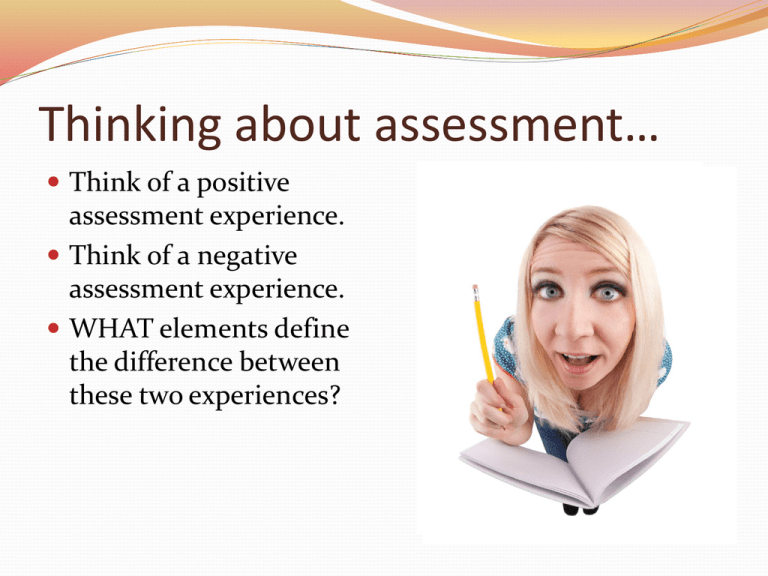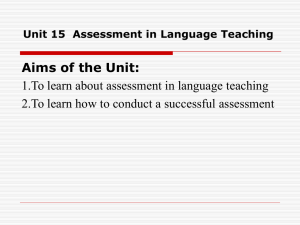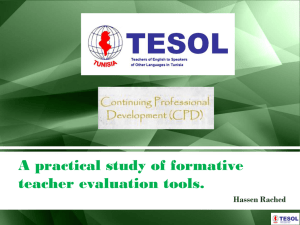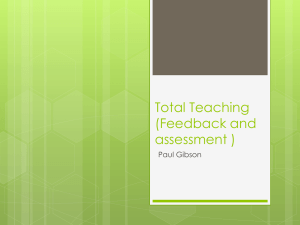Big Picture Assessment
advertisement

Thinking about assessment… Think of a positive assessment experience. Think of a negative assessment experience. WHAT elements define the difference between these two experiences? As a high school student… How were you assessed? What role did you have in assessment? What did assessment do for you? What parts of this practice would you keep? Delete? How does this compare to athletics/music/etc? Assessment What is… Assessment for learning? Assessment as learning? Assessment of learning? Assessment for Learning Purpose Nature of Assessment Use of Information The process of seeking and interpreting evidence for use by learners and their teachers to decide where the learners are in their learning, where they need to go, and how best to get there. Diagnostic – occurs before instruction so teachers can determine students’ prior knowledge and skill It is used by teachers and students to determine what students already know and can do with respect to the expectations, so teacher can responsively plan and help students set goals. Formative – occurs frequently in an ongoing manner during instruction, while student are still gaining knowledge and practicing skills It is used by teachers to monitor students’ progress towards the expectations, so that teachers can provide timely and descriptive feedback to students; scaffold next steps for instruction and assessment. Assessment as Learning Purpose Nature of Assessment Use of Information This focuses on the explicit fostering of students’ capacity over time to be their own best assessors, but teachers need to start by presenting and modelling structured opportunities for students to assess themselves. Formative – occurs frequently during instruction and in an ongoing manner during instruction, with support, modelling, and guidance from the teacher. It helps determine the next steps in learning. It is used by students to provide feedback to other students (peer assessment), monitor their own progress (self assessment), make adjustments in their learning approaches, reflect on their learning and set goals. Assessment of Learning Purpose Nature of Assessment Use of Information It confirms what students know and demonstrates whether or not students have met curriculum goals/outcomes. Summative – occurs at or near the end of a period of learning. Information is designed to provide evidence of achievement to students, parents and educators. Assessment OF Learning FOR & AS Learning Evaluation Assessment Summative (after) Formative Judging Diagnostic (before) & Formative (during, ongoing) Assigning grades & reporting on achievement Coaching Providing feedback to students & teachers to make decisions about next steps in learning Planning with the End in Mind Assessment What do I want them to learn? How will I know they are learning it? How will I design the learning so that all will learn? How will students demonstrate their knowledge and skills while they are learning? How will we monitor their progress? Exit cards, journal entries, observation, conversations, interviews How will I plan with DI in mind? What instructional strategies are appropriate for the learners in my class? Planning with the End in Mind What do I want them to learn? How will I know they have learned it? How will I design the learning so that all will learn? Evaluation How will students demonstrate their knowledge and skills when they have finished learning? What evidence will be produced? • Products • Observations • Conversations Assessment Strategies Informal observation Anecdotal records Observation checklists Rating scales Checklists Scoring guides Performance assessment rubrics Tests and quizzes Daily work Student Conferences Portfolios Graphic Organizers such as concept webs Pre-assessments Article “Keep Behaviour in Report Cards” Reading Strategy: Set the Purpose for Reading You support or negate the author.











